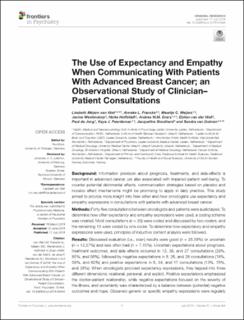| dc.identifier.citation | van Vliet, L. M., Francke, A. L., Meijers, M. C., Westendorp, J., Hoffstädt, H., Evers, A. W. M., . . . van Dulmen, S. (2019). The Use of Expectancy and Empathy When Communicating With Patients With Advanced Breast Cancer; an Observational Study of Clinician–Patient Consultations. Frontiers in Psychiatry, 10(464) | en_US |
| dc.description.abstract | Background: Information provision about prognosis, treatments, and side-effects is important in advanced cancer, yet also associated with impaired patient well-being. To counter potential detrimental effects, communication strategies based on placebo and nocebo effect mechanisms might be promising to apply in daily practice. This study aimed to provide more insight into how often and how oncologists use expectancy and empathy expressions in consultations with patients with advanced breast cancer.
Methods: Forty-five consultations between oncologists and patients were audiotaped. To determine how often expectancy and empathy expressions were used, a coding scheme was created. Most consultations (n = 33) were coded and discussed by two coders, and the remaining 13 were coded by one coder. To determine how expectancy and empathy expressions were used, principles of inductive content analysis were followed.
Results: Discussed evaluation (i.e., scan) results were good (n = 26,58%) or uncertain (n = 12,27%) and less often bad (n = 7,15%). Uncertain expectations about prognosis, treatment outcomes, and side effects occurred in 13, 38, and 27 consultations (29%, 85%, and 56%), followed by negative expectations in 8, 26, and 28 consultations (18%, 58%, and 62%) and positive expectations in 6, 34, and 17 consultations (13%, 76%, and 38%). When oncologists provided expectancy expressions, they tapped into three different dimensions: relational, personal, and explicit. Positive expectations emphasized the doctor–patient relationship, while negative expectations focused on the severity of the illness, and uncertainty was characterized by a balance between (potential) negative outcomes and hope. Observed generic or specific empathy expressions were regularly provided, most frequently understanding (n = 29,64% of consultations), respecting (n = 17,38%), supporting (n = 16,36%), and exploring (n = 16,36%). A lack of empathy occurred less often and contained, among others, not responding to patients’ emotional concerns (n = 13,27% of consultations), interrupting (n = 7,16%), and an absence of understanding (n = 4,9%).
Conclusion: In consultations with mainly positive or uncertain medical outcomes, oncologists predominantly made use of uncertain expectations (hope for the best, prepare for the worst) and used several empathic behaviors. Replication studies, e.g., in these and other medical situations, are needed. Follow-up studies should test the effect of specific communication strategies on patient outcomes, to counter potential negative effects of information provision. Studies should focus on uncertain situations. Ultimately, specific placebo and nocebo effect-inspired communication strategies can be harnessed in clinical care to improve patient outcomes. | en_US |
| dc.rights.holder | Copyright © 2019 van Vliet, Francke, Meijers, Westendorp, Hoffstädt, Evers, van der Wall, de Jong, Peerdeman, Stouthard and van Dulmen. | en_US |

